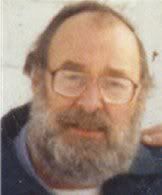In memory of my beloved mentor, colleague and best friend
RAYMOND FELIX JEZERINAC
May 19,1940 - April 21, 1996


I didn't have much to do with Ray until a few years later.
In the mean time I had read a couple of newspaper articles about him.
The articles stated that Ray studied crayfish and was making important discoveries about them.
I remember thinking how boring that sounded, crayfish.
I used to catch them in the creek when I was a boy.
I lived in the country and had a very small stream near the house.
The stream was usually dry and only had water in it in the early spring.
One spring some friends came and visited me. They had two young sons who went out to play along the stream while I socialized with their parents.
Suddenly the boys came in the house all excited carrying a coffee can.
"We caught some crabs in the creek!" they announced.
I looked in the can and there was two good sized crayfish in it.
I was baffled. How could these crayfish live in a stream that was dry 90 per cent of the year?
The next day I saw Ray at school and told him about the crayfish in the usually dry stream.
He was rushed, but asked me to bring them in so he could see them.
The next day I brought the crayfish in to school. Ray was sitting in the cafeteria. I walked up to him and handed him the coffee can with the crayfish.
"Here's the crayfish," I said. Ray took the can, closed his eyes and held the can to his forehead. He held it there a couple seconds and then put the can on the table. "Cambarus cavatus" he stated.
Then he took the lid off the can and looked in. "Yup!" he said, "That's what they are, Cambarus cavatus."
Ray then explained that this species is a secondary burrowing crayfish. This species comes out and wanders the small streams when they have water in them, but when they are dry, they dig down to the water shelf by constructing a burrow.
I asked about the word "secondary". He said that there are also primary burrowing crayfish.
These species only leave their burrows to breed. The burrows are always away from the streams in seeps, wet areas, and roadside ditches.
It was these species that Ray was most interested in.
I asked him how he caught these crayfish if they never come out of their burrows. He replied, "You stick your hand down their hole and feel around until you find them!"
He said he was going collecting that weekend in West Virginia and invited me to go along.
I agreed to go. That weekend we collected crayfish all the way to West Virginia. We would stop and walk creeks catching crayfish. It sent me back to the days of my carefree youth tromping around in the creeks.
Then we found a seep and Ray dug out a burrow with his hand.
Ray slowly dug away at the entrance to the burrow.
As he made the hole big enough for him to stick his hand down the hole, the farther and farther he went down.
Soon he was laying on his stomach in the mud with his entire arm down the hole.
Suddenly he looked up at me and said, "I feel a crayfish! You know what that means?"
"What?" I asked a little hesitantly.
"He is mine!"
Ray worked a while longer trying to get a hold of the crayfish and remove it from the burrow.
He finally extracted the crayfish from the burrow. He glanced at the crayfish which was covered in mud and said, "All right! Your gonna love this!"
He walked over to a puddle in the seep and washed off the crayfish. He then showed this royal blue crayfish. It was beautiful!
I had never seen anything like that.
After seeing the blue crayfish, I was hooked. For 13 years, Ray and I traveled all over the eastern U.S. collecting crayfish.
We logged well over 200,000 miles in that time, exploring mostly the Appalachians, but also the Ozarks and the Great Plains.
I have seen more of rural America than anyone could ever hope to. Ray taught me all about nature, as well as about life.
Ray and that little blue crayfish changed my life, changed my world and changed me.
Picture 1. Ray digging out burrowing crayfish in Mississippi, 1985.
Picture 2. When Ray got REALLY serious about digging out burrowing crayfish, 1986.
Picture 3. Ray and the Crayfish God's burrow, Indiana 1986.
Picture 4. Ray digging out burrowing crayfish in Maryland, 1984.
Picture 5. I don't know who that seedy character is with Ray, Maryland 1984.
The following pictures were given to me by Ray's daughter. THANKS Rebecca!
Picture 6. Ray on Spruce Knob, WV, late 70's or early 80's.
Picture 7. Ray and his sons, January 1994.
Picture 8. Ray canoeing with son and daughter, 1994.
Picture 9. Ray with son and daughter, 1995.
Picture 10. Ray with daughter at Lake Erie, 1994.
Picture 11. Ray the graduate.

You are visitor
since 21 February 1999
FastCounter by LinkExchange
